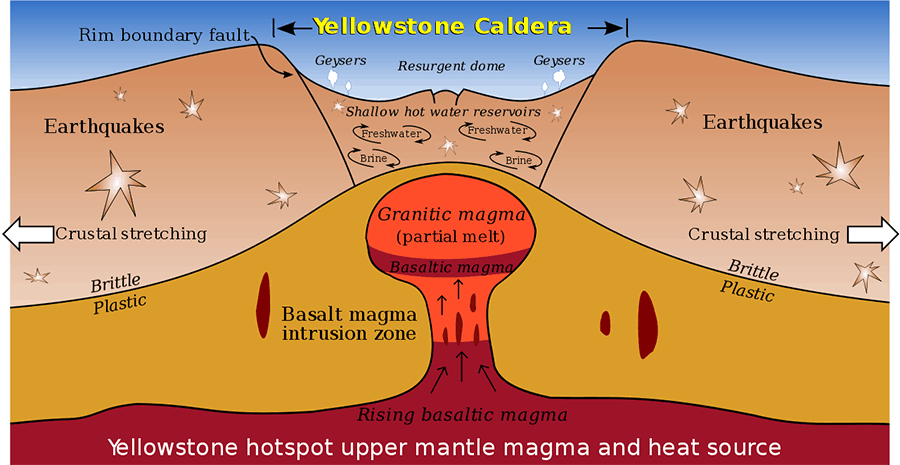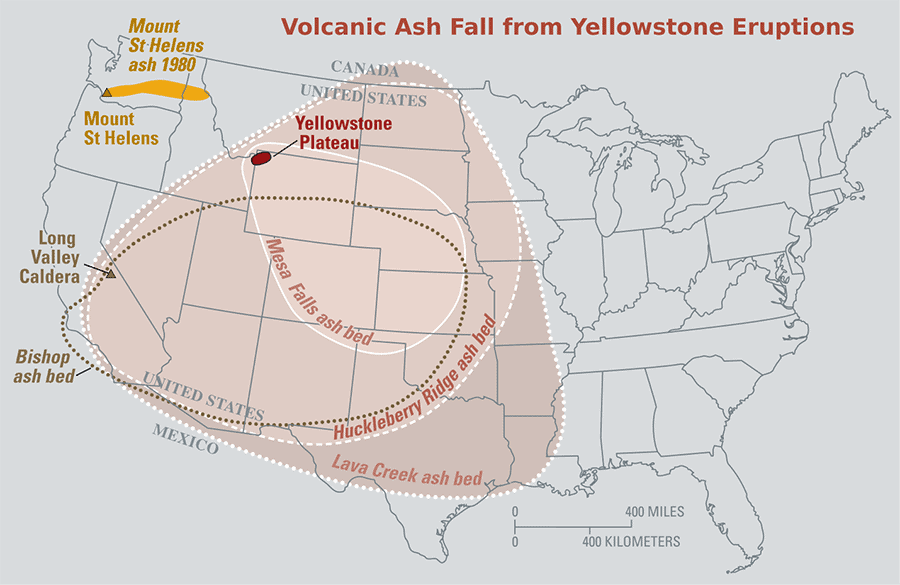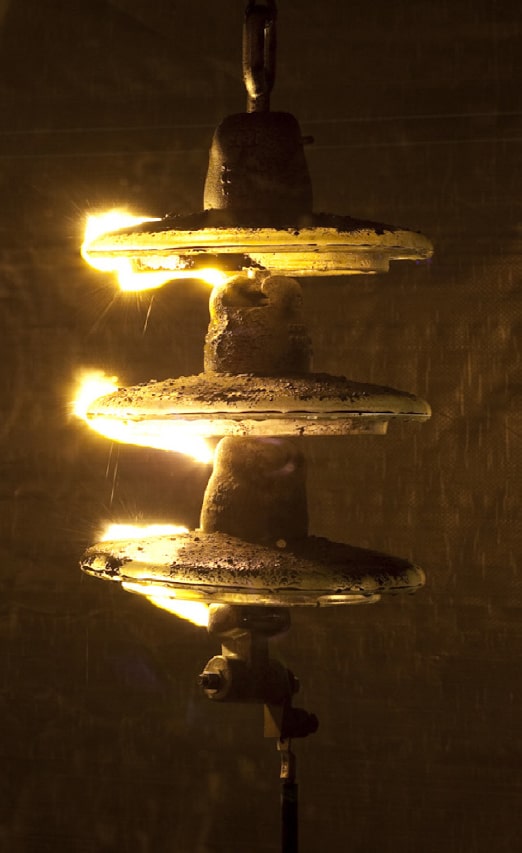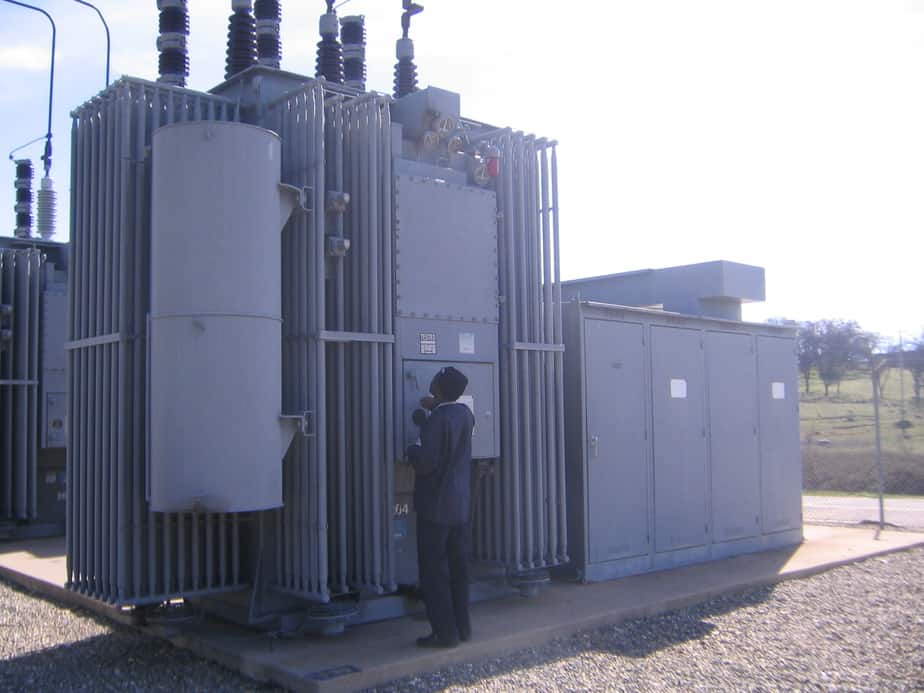We all fear volcanic eruptions with their flowing lava and fireballs. However, the volcanic ashfall effects on our power grid go unnoticed.
Having delved into the disastrous consequences of a powerful coronal mass ejection striking Earth, I’m turning my attention to the potential havoc brought by volcanic eruptions. And we’re not just talking about any old eruption here; we’re focusing on the colossal supervolcano tucked away in the breathtaking Yellowstone National Park.
What’s the deal with a mega volcanic eruption?
It’s been ages since we’ve seen a volcanic eruption of truly epic proportions in our modern history. The nearest thing we have is the monstrous Mount Saint Helens eruption, which shook Washington State to its core back in 1980.
But don’t be fooled! The term massive barely scratches the surface when it comes to eruption scales, and the data I’ve collected below will back me up on this. Let’s compare the 1980 Mount Saint Helens eruption to some of the most legendary volcanic eruptions of the past:
| Volcano name | Eruption time period | Volume of erupted magma |
|---|---|---|
| Toba | 74,000 years ago | 671.8 cubic miles |
| Yellowstone Huckleberry Ridge | 2.1 million years ago | 587.8 cubic miles |
| Yellowstone Lava Creek | 640,000 years ago | 239.9 cubic miles |
| Long Valley Caldera | 760,000 years ago | 139.1 cubic miles |
| Yellowstone Mesa Falls | 1.3 million years ago | 67.2 cubic miles |
| Mount St. Helens | 30 years ago (1980) | 0.06 cubic miles |
Here’s the kicker: a supervolcano—Yellowstone—is lurking right in our backyard. These types of volcanoes are exceptionally rare on Earth, and if one were to blow its top, it would make the Mount Saint Helens eruption look like a teensy hiccup by comparison.
To help paint a picture of the looming danger, feast your eyes on this jaw-dropping schematic of the Yellowstone hotspot. It shows how magma and pressure are steadily building up beneath the caldera.

When it comes to volcanic eruptions, there’s a whole laundry list of hazards to fret over, including:
- Lava flows and domes
- Volcanic gases
- Large mudflows
- Volcanic earthquakes
- Tephra release
But the thing that really gets me sweating is the tephra fallout. Tephra encompasses all the material spewed from a volcano, including chunks of rock and ash. And speaking of ash, these minuscule particles (measuring less than 2 millimeters across) can unleash widespread chaos.
Picture this: supervolcanoes can whip up ferocious intercontinental winds during an eruption, which means ash can travel thousands of miles and unleash devastation far and wide.
How does volcanic ashfall mess with the U.S. power grid?
Let’s break it down into five key factors we need to consider when it comes to eruption-generated ash.
#1 Amount of ash released
The more ash spewed out, the bigger the headache. Just like how more floodwater leads to greater damage. But the length of the ashfall is equally critical. The average duration of an eruption is 7 weeks, but for a supervolcano like Yellowstone, that’s anyone’s guess. The eruption could drag on for weeks, months, or even years.
To wrap your head around the possible fallout from ashfall, check out the graphic below. It stacks up past Yellowstone eruptions against the Mount Saint Helens eruption. The difference is staggering. Even though Mount Saint Helens was labeled a major natural disaster, the Yellowstone eruptions were on an entirely different level.
Don’t get me wrong—the Mount Saint Helens eruption was lethal, and the economic fallout clocked in at nearly a billion dollars. But when stacked up against the potential impact of a Yellowstone supervolcano eruption, it’s small potatoes.

#2 Ash content
When it comes to volcanic ash, the devil’s in the details. The composition of ash can vary wildly from one volcano to another, and this can seriously impact the damage caused. Here are some key factors to keep in mind:
- Ash chemistry: This deals with the soluble salt content and electrical properties for conductivity. Volcanic ash loves to soak up moisture, and saltwater’s a fantastic conductor of electricity. So, ash with a higher salt content will be more electrically conductive.
- Wet or dry ash: When an eruption spews out water vapor, wet ash is born. Damp ash loves to cling to surfaces, and the salt content in ash dissolves when wet, making it more electrically conductive.
- Size of ash particles: Particle size distribution and shape matter too. Think spherical or angular-shaped ash particles. The bigger the surface area of an ash particle, the better it conducts electricity when wet. This creates a smoother path for electricity to flow.
- Compaction level of ash: The more tightly packed the ash, the better it conducts electricity when wet. That’s because ash particles will be snugger, letting electricity flow more easily.
#3 Weather conditions at the time of an eruption
The weather conditions during a volcanic eruption play a massive role in determining the damage done. Here’s what we need to consider:
- Dry weather: If it’s dry during the eruption, we’ll face fewer problems. The ash is less likely to stick to insulators, and it won’t be as conductive.
- Rain: There’s a fine line when it comes to rain. Too much rain, and the ash washes off, which is perfect. But just enough rain makes the ash stick and become electrically conductive.
- Light drizzle or high humidity: These conditions make life tougher during an eruption. The ash will be more likely to stick to surfaces and become conductive, leading to extra problems.
#4 Eruption strength
The strength of a volcanic eruption is critical for the amount and duration of ashfall. The greater the eruption energy, the higher the ash is blasted into the sky.
As a result, the ash can travel further and wreak even more havoc.
#5 Human preparation for an eruption
As much as we’d like to think we’re ready for anything, the truth is we’re woefully unprepared for a supervolcano eruption.
Sadly, this also means the threat is often overlooked or ignored because it’s not something we’ve faced before. But let me tell you, if it does happen, it’ll be worse than any major earthquake or hurricane we’ve ever endured.
Now, with all that in mind, let’s dive into the impact of volcanic ash on our power grid.
#1 System outages from insulator flashovers
First things first, let’s talk about insulators. It’s electrical hardware that serves two crucial purposes:
- Mechanically support energized lines or electrical parts. Electrical conductors can be pretty heavy, so insulators are used to prop them up when they’re mounted to poles or towers.
- Electrically isolate energized lines or electrical parts. As the name suggests, insulators prevent the flow of electric current. They’re specially shaped using the right materials to stop electric current flow. Overhead conductors connected to transmission towers use insulators to prevent electric current from zipping from the cables through the tower to the ground.
So, what’s an insulator flashover? It’s a disruptive electrical discharge that happens over an insulator’s surface.
Here’s how it can go down: The surface of an insulator gets wet, allowing pollutants in the air to create a conducting path on the insulator. The electric conducting path improves as pollutants stick to the insulator. This is when leakage current comes into play, where a small amount of electric current flows across an insulator’s surface.
If the electric current flow is strong enough, a flashover occurs, causing the electric current to flash across the insulator’s surface. In the image below, you can see a high-voltage insulator covered with 3 millimeters of wet volcanic ash, which causes a flashover.

The link between flashovers and climate
Flashovers are more likely to happen in humid states, as listed in the table below. Luckily, the states surrounding Yellowstone’s hotspot, like Montana, Idaho, and Wyoming, aren’t the most humid.
But, if the eruption spews wet ash, even the driest states will feel the burn. In these cases, only excessive rain can wash off the ash.
Plus, the impact of a supervolcano eruption on our atmosphere is unpredictable. The ash can soar as high as 30,000 miles into the sky, which is more than four times the height of a commercial jet.
| State | Average total yearly precipitation | Rank among 50 states |
|---|---|---|
| Nebraska | 23.6 inches | 38 |
| South Dakota | 20.1 inches | 41 |
| Idaho | 18.9 inches | 42 |
| North Dakota | 17.8 inches | 43 |
| Colorado | 15.9 inches | 44 |
| Montana | 15.3 inches | 45 |
| Wyoming | 12.9 inches | 48 |
| Utah | 12.2 inches | 49 |

Important Note: Dry ash doesn’t conduct electricity well enough to cause insulator flashovers. Plus, it only falls and sticks to horizontal surfaces.
But, if the weather’s even a tad wet, wet ash will cling to everything exposed. This means the season when a volcanic eruption occurs is crucial, especially since a volcano might only release dry ash.
Above-ground electric lines
In the U.S., we have thousands of miles of overhead electric lines, used for:
- Generation
- Transmission
- Distribution
These lines, with their own set of insulators, are all exposed to ashfalls in areas like:
- Your neighborhood
- City centers near buildings
- Running across highways
- Hidden on mountains
Now, the voltage rating of the electric lines is also essential. For example, during the 1980 Mount Saint Helens eruption, nearby transmission networks with voltages ranging from 110 kilovolts to 500 kilovolts held up well. These insulators could withstand 6 to 9 millimeters of ash before flashovers occurred.
In contrast, lower voltage electric lines ranging from 33 kilovolts down to 480 volts saw more damage. This is because the surface area of these insulators is smaller, increasing the risk of flashovers. As a result, people living around the volcano experienced hours of outages.
Outdoor power transformers
Flashovers kick in when an electric discharge zaps across the insulation (bushing) of padmount power transformers. This can burn or crack the bushing and wreak havoc on internal parts like the windings. Fixing the windings could take months and cost an arm and a leg.
But wait, there’s more. Ash can deal a heavy blow to pole-mounted transformers too. As ash piles up around the terminals, it can cause leakage current, leading to cables burning out.
And if a transformer at a generation plant goes kaput, it could set off a domino effect. Picture a transformer at a hydropower plant. Its job is to boost voltage, sending power zipping through transmission lines to folks like you and me.
Now, let’s say this transformer conks out. Everything powered by this hydroelectric plant would lose power. Other power sources would probably have their own issues, too. So, it’s a domino effect, and we can’t just reroute the power.
Longterm effects from flashovers
Flashovers don’t just trigger short-term headaches; they can also have long-term effects. When leakage current zips across high-voltage insulators, it can cause burning and etching on the surface of the insulator.
You might not notice any problems right away, but this damage can compromise the insulator’s effectiveness down the road.
#2 Electrical line breakage due to ash loading
In a bunch of U.S. states, overhead electrical lines will grapple with some level of ash accumulation.
The weight of the ash can spell big trouble, especially when wet, as it adds more heft to the lines. Just picture all the potential ash buildup on the steel towers and wooden poles you see outside.
On top of that, ash can tumble onto overhanging vegetation, piling on extra weight that can snap branches onto power lines. And there are loads of spots with trees growing right next to power lines. This not only damages power lines but also raises the risk of starting fires – the last thing we need after a supervolcano eruption.
#3 Abrasion and corrosion of outdoor electrical equipment
Volcanic ash is a major pain for metal parts. It accelerates erosion, but we might not even spot the damage until months later – kind of like that sneaky leakage current we mentioned earlier.
Moving parts are especially at risk. Volcanic ash is made up of hard and angular particles that can gum up mechanical parts. In fact, it could even cause failure or jam the mechanical parts completely.
Imagine those massive wind turbines you see from afar when cruising down highways. These turbines have giant blades spinning in the air, which means they have tons of moving parts that could easily get clogged by volcanic ash.
And when the ash gets wet, that’s when the real trouble starts. It turns corrosive, spelling disaster for electrical equipment that’s mostly made of metal.
Substation power transformers

Gigantic substation transformers need multiple fans to keep their cool. Without them, these transformers could overheat in no time, especially during high-usage periods in scorching weather.
But when volcanic ash enters the mix, these transformers face a whole new set of hurdles. Ash can clog up air-intake systems, seriously messing with airflow. And here in California, many electrical devices depend on air cooling systems just to function properly because of the state’s sizzling weather.
#4 Change in substation surface rock sensitivity
When volcanic ash piles up on a substation’s surface, it can cause a whole heap of trouble. The ash slashes the ground resistance of the substation, and when it gets wet, it turns electrically conductive.
This build-up messes with step and touch potential, which is the voltage difference between two points. For step potential, we’re talking about the voltage between the feet of someone standing next to an energized, grounded object. And for touch potential, we’re talking about the voltage between an energized object and the feet of a person touching that object.
Here’s the kicker: when the substation’s surface resistivity drops, more electric current can zap through a human body. This spells danger for substation operators, as the risk of electrocution shoots up, especially if the equipment is still energized after a volcanic eruption.
#5 Disruption of power generation facilities
A boatload of ash can wreak havoc on any equipment that needs air intake, as we’ve discovered. The ash can block up the air intakes, causing a dip in air quality and quantity.
Loads of equipment are vulnerable to this, including:
- Turbines
- HVAC
- Transformers
- Generators
Let’s zoom in on generators, though, since they’re the heart and soul of all power generation. They have tons of moving parts and demand proper airflow, which is a major concern.
While new equipment is built to withstand harsh conditions, they’re usually designed to handle normal extreme operating conditions, not volcanic eruptions.
Imagine dropping a brand-new piece of equipment in a desert with never-ending sandstorms. It’d probably fail in a flash. The conditions during a supervolcano eruption would be way worse than a sandstorm.
For instance, in the United States, there are about 2,400 hydropower plants, each with its unique design. Many of these plants are old and outdated, making them even more susceptible to damage.
The heaps of ash, which would enter a dam, are a huge problem. The ash-filled water would rush through all the hydroelectric equipment and could damage various parts of the facility, including:
- Runner blades
- Wear rings
- Seals
- Wicket gates
And if hydroelectric plants keep chugging along as ash rains from the sky, the damage could be devastating.
What would be the worst-case outcome of the Yellowstone supervolcano eruption?
Imagine a world where the lights go out, where the hum of electricity suddenly vanishes, and the things we take for granted become distant memories. This is the grim possibility we face if the Yellowstone supervolcano erupted, smothering everything in endless ash.
The most significant damage would hit critical equipment, including:
- Power transformers
- Distribution and transmission lines
- HVAC units
- Generators
In a nutshell, large chunks of the power grid could shut down, and millions of people could be left without electricity, either by choice or due to equipment failure.
Rebuilding and repairing this widespread damage could take years and change life as we know it.
What can we do to limit the damage to power grids from the Yellowstone supervolcano eruption?
I’m going to walk you through five protective measures we can take to help limit the damage from a supervolcano eruption. While we can’t entirely dodge the damage, taking action ahead of time can help minimize its impact.
#1 Add protective coatings to prevent erosion and pitting
Applying a protective coating to exposed electrical parts is an effective way to minimize corrosion caused by wet volcanic ash. For example, we can apply this coating to the following parts of a turbine:
- Runner blades
- Wear rings
- Band seals
- Cheek plates
#2 Create hydroelectrical plant bypass channels
Adding a specially designed floodgate system, similar to a water bypass, can steer ash-filled water flow away from the generation components. This helps prevent the ash from zipping through the turbine channel and causing damage.
However, this calls for dam operators to keep a close eye on any volcanic eruption. While many hydropower plants already have this bypass system built in, others don’t.
#3 Plan power system shutdowns
The best way to limit damage is by taking equipment offline and sealing and covering them. This is particularly important for big-ticket items like power transformers, which are susceptible to overheating and flashovers from ash build-up. Not to mention, these transformers are pricey to replace and have a long lead time even under normal circumstances.
However, it’s not a decision to be made lightly. Shutting down a critical power transformer to dodge $50,000-plus in damages might not always be wise, as the shutdown can cost millions of dollars for customers who rely on the power.
After an eruption, grid operators need to make quick decisions and communicate with their customers if power cuts are necessary.
#4 Speedy cleanup for electrical equipment
When it comes to cleaning ash off electrical equipment, especially the soggy stuff, time is of the essence. Left to linger, ash clings to surfaces like superglue, making removal a beast and ramping up the risk of flashovers and further damage.
During a supervolcano blowout, ash will smother insulators as far as the eye can see, turning the cleanup of tens of thousands of them into a Herculean task. While helicopters usually swoop in to hose down insulators, ash-choked skies will keep them grounded.
This means we’ll have to grit our teeth through a boatload of controlled outages during the ash cleanup, leaning hard on diesel-powered generators. But let’s not forget, those generators need some TLC to stop them from inhaling a lungful of ash.
#5 Upgrade power system equipment
Loads of newfangled equipment designs can fend off pesky ash particles. But here’s the kicker: a large chunk of our power grid gear is old and creaky, which spells trouble with a capital T.
To dodge costly damage during an eruption, we’ve gotta hit fast-forward on modernizing our rickety power grid and amp up equipment maintenance. It’s one thing to play fast and loose with your home fridge’s upkeep, but ignoring mega-pricey equipment? That’s just nuts. Leaving a $300,000 piece of equipment to gather dust and rust outdoors? Unthinkable, but it’s happening all over!
By showering our equipment with some much-needed TLC, we can sidestep a world of pain. Facility operators are already in a mad dash for emergency generator fixes during the good times, thanks to neglect. Imagine the chaos during a supervolcano eruption without proper care…
Conclusion
The colossal chaos a volcanic eruption could cause often flies under the radar, but it’s a legit threat.
The freaky part? We’re pretty clueless about supervolcanoes, despite having one lurking in our own backyard. These geological monsters are shrouded in mystery, including the havoc they could wreak on electrical equipment.
I hear folks saying electrical gear would mostly survive an eruption. But truth be told, we don’t have enough supervolcano intel to make such a bold statement. Plus, we’re in the dark about the atmospheric conditions a humongous eruption would whip up.
We need a solid national game plan, chock-full of no-nonsense standards and guidelines. We don’t need to blow our budget prepping for a “what if” scenario, but taking reasonable steps to gear up for it is a must.
Whether a supervolcano lets loose tomorrow or half a million years from now, being ready is key. In fact, getting prepped could even give our power grid a much-needed facelift, making it tougher and more reliable.
So, do you think we’re geared up for a supervolcano eruption? What’s your take on the impact of Yellowstone’s supervolcano blowing its top? And how about volcanic ashfall effects on the power grid – what are your thoughts on that?
Featured Image Photo Credit: NASA (image cropped)

Процесс получения диплома стоматолога: реально ли это сделать быстро?